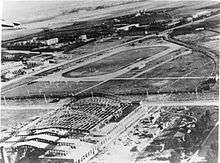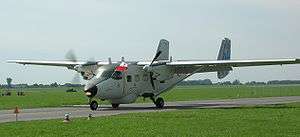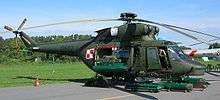PZL
PZL (Państwowe Zakłady Lotnicze - State Aviation Works) was the main Polish aerospace manufacturer of the interwar period, and a brand of their aircraft. Based in Warsaw between 1928 and 1939, PZL introduced a variety of well-regarded aircraft, most notably the PZL P.11 fighter, the PZL.23 Karaś light bomber, and the PZL.37 Łoś medium bomber.
In the post-war era, aerospace factories in Poland were initially run under the name WSK (Transport Equipment Manufacturing Plant), but returned to adopt PZL acronym in late 1950s. This was used as a common aircraft brand and later as a part of names of several Polish state-owned aerospace manufacturers referring to PZL traditions, and belonging to the Zjednoczenie Przemysłu Lotniczego i Silnikowego PZL - PZL Aircraft and Engine Industry Union. Among the better-known products during this period is the PZL TS-11 Iskra jet trainer and PZL-104 Wilga STOL utility aircraft.
After the fall of communism in Poland in 1989, these manufacturers became separate companies, still sharing the PZL name. In the case of PZL Mielec, the abbreviation was later developed as Polskie Zakłady Lotnicze - Polish Aviation Works. Over time, most of the now-separate divisions were purchased by foreign concerns, and some continue to use PZL brand.
PZL (1928-1939)

The PZL - Państwowe Zakłady Lotnicze (State Aviation Works) was founded in Warsaw in 1928 as a state-owned company, and was based on the earlier CWL (Centralne Warsztaty Lotnicze) - Central Aviation Workshops.[1] First to be produced was a licensed version of a French fighter, the Wibault 70, but from then on the company produced exclusively its own designs. In the next decade a talented designer Zygmunt Puławski designed a series of high-wing, all-metal modern fighters: PZL P.1, P.6, P.7 and P.11. The latter two types were used as basic fighters in the Polish Air Force from 1933 onwards. The last variant, PZL P.24, developed after Puławski's death in an air crash, was exported to four countries. PZL also mass-produced a light bomber, PZL.23 Karaś, and a modern medium bomber, PZL.37 Łoś, as well as building small numbers of sport aircraft (PZL.5, PZL.19, PZL.26), and liaison aircraft (PZL Ł.2); and developing prototypes of passenger aircraft. In the late 1930s the company also developed several prototypes of more modern fighters and bombers — and a passenger airliner, the PZL.44 Wicher. However, World War II prevented these aircraft from entering production. PZL was the largest Polish pre-war aircraft manufacturer.
In 1934, the main factory in Warsaw was named PZL WP-1 (Wytwórnia Płatowców 1 - Airframe Works 1) in the Okęcie district of Warsaw. A new division PZL WP-2 was built in Mielec in 1938-1939, but production was only just starting there at the outbreak of World War II.[1] An engine factory division, PZL WS-1 in Warsaw-Okęcie (Wytwórnia Silników - Engine Works 1), produced mostly licensed versions of British Bristol engines, such as the Bristol Pegasus and the Bristol Mercury. The WS-1 factory was former Polskie Zakłady Skody, the Polish division of Skoda Works, and was nationalized and renamed in 1936. In 1937-1939 a new engine division, PZL WS-2, was built in Rzeszów.[2]
Situation post-war
During World War II and five-year occupation, all Polish aviation industry was taken over by German firms, and as a result, almost completely destroyed. By the end of the war, all factories were either ruined, or robbed from tooling.[3] Despite it, from 1944 there were carried out efforts to design new aircraft, in primitive conditions (first of all, in the LWD). No engines nor suitable production facilities were available at first.[4] The post-war communist government of Poland wanted to break all connections with pre-war Poland: from the late 1940s the name PZL ceased to be used, and new aerospace factories were named WSK (Wytwórnia Sprzętu Komunikacyjnego - Transport Equipment Manufacturing Plant). Under the Soviet-influenced, centrally planned economy, all indigenous projects were abandoned, in a favour of manufacturing Soviet-licensed aircraft.[4] No own designs were produced for a decade, and only in late 1950s, after the stalinist period (1956), did the PZL brand return to designing new aircraft.
The ZPLiS PZL - Zjednoczenie Przemysłu Lotniczego i Silnikowego PZL - PZL Aircraft and Engine Industry Union, which grouped all state-owned aerospace industry factories, was created in following years, but it only enjoyed some economic autonomy from 1973 onwards.[5] It consisted of 19 factories, a research institute, and the Pezetel Foreign Trade Center - CHZ Pezetel, which represented all the Polish aerospace industry abroad (Pezetel being the pronunciation of an abbreviation PZL in Polish).[5] Consequently, in the 1970s some WSK factories also introduced the PZL abbreviation to their names. After the fall of communism in Poland in 1989, all manufacturers became separate companies, initially state-owned, still sharing the PZL name.
PZL "Warszawa-Okęcie"
The main factory PZL WP-1 in Warsaw was destroyed during World War II, mostly during the German evacuation in 1944. In 1946, the CSS construction bureau (Centralne Studium Samolotów - Central Aircraft Study) was set up there. As the factory was rebuilt, it was renamed in 1950 as the WSK Nr.4, and in 1956 as the WSK-Okęcie.[6]
It first produced licensed versions of Soviet types and aircraft developed by other Polish companies. From 1958 onwards it started to produce its own designs under the PZL brand, starting with the PZL-101 Gawron. The factory developed mainly light sports, trainer and utility aircraft. An attempt of producing and airliner PZL MD-12 was unsuccessful. The best-known designs are the PZL-104 Wilga utility aircraft, which was produced in larger numbers than any other Polish-designed aircraft; and the PZL-106 Kruk agricultural aircraft. During the 1970s the factory adopted the name WSK "PZL Warszawa-Okęcie", which after the fall of the communist system was changed in 1989 to PZL Warszawa-Okęcie. In 2001 the factory was bought by the Spanish company EADS CASA (now part of Airbus Defence and Space) and since then has been known as EADS PZL Warszawa-Okęcie SA.
WSK "PZL-Mielec" / PZL Mielec

The PZL WP2 factory in Mielec became a part of Heinkel during the German occupation of Poland, and manufactured parts for German aircraft. After the war the factory was named first PZL No.1 works,[7] then from 1949 WSK-Mielec, and later WSK "PZL-Mielec". It became the biggest post-war Polish aircraft producer.[7] It manufactured mostly licensed Soviet types, such as the Antonov An-2 transport biplane and early jet fighters: Mikoyan-Gurevich MiG-15 (as Lim-1 and Lim-2) and Mikoyan-Gurevich MiG-17 (as Lim-5 and Lim-6). It also produced the Polish-designed TS-8 Bies piston trainer and TS-11 Iskra jet trainer, and the PZL M-15 Belphegor the world's only jet agricultural aircraft. Large numbers of aircraft were exported abroad, mostly to the USSR.[7] From the 1970s onward it produced mostly its own developments of licensed civil aircraft, the best known are the PZL M-18 Dromader agricultural aircraft, which was exported to numerous countries, and the PZL M-28 Skytruck/Bryza light transport aircraft. In 1998 the state factory WSK PZL-Mielec went bankrupt and was changed into the state-owned Polskie Zakłady Lotnicze Sp.z o.o. (Polish Aviation Works) (PZL Mielec).
On March 16, 2007, PZL Mielec was purchased by the Sikorsky Aircraft Corporation, a unit of United Technologies Corporation (UTX). It still produces M-18 and M-28 aircraft.
WSK "PZL-Świdnik"
In 1951 a third national aerospace factory, WSK-Świdnik, was built in Świdnik,[8] and in 1957 it was renamed to WSK "PZL-Świdnik". Since 1956 it has become one of the world's major helicopter manufacturers, producing helicopters under Soviet licences, starting from the SM-1 (Mil Mi-1).[8] Świdnik was the main producer of the Mi-1 and the exclusive producer of the Mil Mi-2, which was widely used throughout the world. Since the late 1980s, Świdnik has been producing a Polish-designed medium helicopter PZL W-3 Sokół. It also produces a light helicopter, the PZL SW-4 Puszczyk. After 1991 the state factory became a state-owned corporation (WSK "PZL-Świdnik" SA). It also produced the SZD-30 Pirat, PW-5 and PW-6 gliders and cooperates widely with other nations' manufacturers, e.g., in the manufacture of Agusta A109 fuselages.
In early 2010 the factory was acquired by AgustaWestland (helicopters division under the Leonardo Helicopters brand).
PZL-Bielsko
| Wikimedia Commons has media related to PZL Bielsko gliders. |
Glider manufacturer SZD (Szybowcowy Zakład Doświadczalny - Glider Experimental Works) was created in Bielsko-Biała in 1948 and was renamed to PZL-Bielsko only in the 1990s. The main Polish producer of gliders, its products were exported to many countries. However, for most of its history it did not carry PZL name. Currently it is named Allstar PZL Glider Sp.z o.o. (from 2002).
WSK-Rzeszów
The engine division WS-2 of the PZL was built in Rzeszów in 1937-1939[2]. After the war it still bore a name PZL (Państwowe Zakłady Lotnicze) until 1951, when it was renamed WSK-Rzeszów.[9] From 1949 it manufactured Soviet-licensed M-11 engines, later, among others, ASh-62IR, turboshaft engines GTD-350 and Polish jet engines SO-1.[9]
WSK "PZL-Kalisz"
In 1952 the engine manufacturer WSK-Kalisz was created. It manufactured mostly Soviet-licensed engines, first piston (the Shvetsov ASh-82 and the Ivchenko AI-14) and then jet (the Klimov VK-1). It also produced Polish piston engines, such as the WN-3, and other equipment. In October 1996 it was renamed WSK "PZL-Kalisz" and became a corporation (SA).
WSK "PZL Warszawa II"
WSK Warszawa II was created in 1952 in Warsaw as a manufacturer of aircraft parts and military equipment parts. In 1995 it was changed from a state factory to a corporation WSK "PZL Warszawa II" SA.
A list of aircraft designed or produced by PZL


A date of first prototype flight / serial production start is given ("-" for not flown or not produced aircraft)
| PZL (before 1939) | |
|---|---|
| PZL P.1 | 1-engine, fighter prototype, high-wing, 1929/- |
| PZL Ł.2 | 1-engine, liaison, high-wing, 1929/1930 |
| P.Z.L. 3 | 4-engine heavy bomber project, 1928/1930 |
| PZL.4 | 3-engine, passenger prototype, high-wing, 1932/- |
| PZL.5 | 1-engine, sport, biplane, 1930/1931 |
| PZL P.6 | 1-engine, fighter prototype, high-wing, 1930/- |
| PZL P.7 | 1-engine, fighter, high-wing, 1930/1932 |
| PZL P.11 | 1-engine, fighter, high-wing, 1931/1934 |
| PZL.12 | 1-engine, amphibious flying-boat prototype, 1931 |
| PZL.16 | 1-engine, passenger aircraft prototype, 1932 |
| PZL.19 | 1-engine, sport, low-wing, 1932/- |
| PZL.23 Karaś | 1-engine, light bomber, low-wing, 1934/1936 |
| PZL P.24 | 1-engine, fighter, high-wing, 1933/1936 |
| PZL.26 | 1-engine, sport, low-wing, 1934/- |
| PZL.27 | 3-engine, passenger prototype, high-wing, 1934/- |
| PZL.30 Żubr | 2-engine, medium bomber, high-wing, 1936/1938 |
| PZL.37 Łoś | 2-engine, medium bomber, low-wing, 1936/1938 |
| PZL.38 Wilk | 2-engine, heavy fighter prototype, low-wing, 1938/- |
| PZL.43 | 1-engine, light bomber, low-wing, developed from PZL.23 |
| PZL.44 Wicher | 2-engine, passenger aircraft prototype, low-wing, 1938/- |
| PZL.45 Sokół | 1-engine, fighter prototype, low-wing, -/- |
| PZL.46 Sum | 1-engine, light bomber prototype, low-wing, 1938/- |
| PZL.48 Lampart | 2-engine, heavy fighter prototype, low-wing, -/- |
| PZL.49 Miś | 2-engine, medium bomber prototype, low-wing, -/- |
| PZL.50 Jastrząb | 1-engine, fighter prototype, low-wing, 1939/- |
| PZL.53 Jastrząb II | 1-engine, fighter project, low-wing, -/- |
| PZL.54 Ryś | 2-engine, heavy fighter prototype, low-wing, -/- |
| PZL.55 | 1-engine, fighter project, low-wing, -/- |
| PZL.56 Kania | 1-engine, fighter project, low-wing, -/- |
| CSS -> WSK-Okęcie -> PZL "Warszawa-Okęcie" | |
| CSS-13 | 1-engine, multirole biplane, 1948 (licence Polikarpov Po-2) |
| LWD Junak | 1-engine, trainer low-wing, 1948/1951 |
| Jak-12 | 1-engine, multirole high-wing, 1956 (licence Yakovlev Yak-12) |
| PZL-101 Gawron | 1-engine, multirole (agricultural) high-wing, 1958/1960 |
| PZL-102 Kos | 1-engine, sports low-wing, 1958/1959 |
| PZL-104 Wilga | 1-engine, multirole high-wing, 1963/1964 |
| PZL-105 Flaming | 1-engine, multirole high-wing, 1989/- |
| PZL-106 Kruk | 1-engine, agricultural low-wing, 1973/1977 |
| PZL-110 Koliber | 1-engine, trainer / sport low-wing, 1978 (licence SOCATA Rallye 100ST) |
| PZL-112 Junior | 1-engine, trainer prototype, 2000 |
| PZL-130 Orlik | 1-engine, military trainer low-wing, 1984/1992 |
| WSK-Mielec -> PZL-Mielec | |
| LWD Szpak-4T | 1-engine, utility / touring low wing, 1945/1948 |
| PZL S-1 | 1-engine, trainer and liaison prototype, 1945/1946 |
| PZL S-4 Kania | 1-engine, trainer and glider tug, 1951-1964 |
| PZL TS-8 Bies | 1-engine, military trainer low-wing, 1955/1957 |
| PZL M-2 | 1-engine, trainer low-wing prototype, 1958/- |
| PZL M-4 Tarpan | 1-engine, trainer low-wing prototype, 1961/- |
| An-2 | 1-engine, transport and multirole biplane, 1960 (licence Antonov An-2) |
| Lim-1 | 1-jet engine, fighter, 1953 (licence MiG-15) |
| Lim-2 | 1-jet engine, fighter, 1954 (licence MiG-15bis) |
| Lim-5 | 1-jet engine, fighter, 1956 (licence MiG-17) |
| PZL-Mielec Lim-6 | 1-jet engine, attack aircraft, 1961 |
| PZL TS-11 Iskra | 1-jet engine, military trainer, mid-wing, 1960/1963 |
| PZL M-17 | 2-engine, general aviation and trainer prototype, 1977 |
| PZL M-15 Belphegor | 1-jet engine, agricultural biplane, 1973/1976 |
| PZL M-18 Dromader | 1-engine, agricultural low-wing, 1976/1978 |
| PZL M-20 Mewa | 2-engine, multirole low-wing, 1979/1989 (licence Piper Seneca) |
| PZL M-21 Dromader Mini | 1-engine, agricultural low-wing, 1987/- |
| PZL M-24 Dromader Super | 1-engine, agricultural low-wing, 1987/- |
| PZL M-26 Iskierka | 1-engine, trainer low-wing, 1986/? |
| PZL M-28 Skytruck / Bryza | 2-turboprop engine, light transport / military high-wing, 1984 (developed Antonov An-28) |
| PZL I-22 Iryda | 2-jet engine, military trainer, high-wing, 1985/1992 (small series built) |
| WSK "PZL Świdnik" -> PZL-Świdnik | |
| PZL SM-1 | light helicopter (1+2/3 seats), 1957 (licence built Mil Mi-1) |
| PZL SM-2 | light helicopter (1+4 seats), 1962 |
| PZL Mi-2 | helicopter (2+8 seats), 1966 (licence Mil Mi-2) |
| PZL SM-4 Łątka | helicopter |
| PZL Kania | helicopter (2+8 seats), 1979/1986 |
| PZL W-3 Sokół | helicopter (2+12 seats), 1979/1987 |
| PZL SW-4 Puszczyk | light helicopter (1+4 seats), 1996/2003? |
| Engines | |
| PZL-3 | 7-cylinder radial |
Other types of aircraft
- PZL-126 Mrowka - Agricultural aircraft.
- PZL-230 Skorpion - Ground-attack aircraft project.
- PZL Krosno KR-03 Puchatek - glider
References
- A. Glass (1977), p. 26-31
- A. Glass (1977), p. 41-44
- Babiejczuk, J. and Grzegorzewski, J. (1974), p. 54
- Cynk, Jerzy B. (4 January 1962). "Progress in Poland". Flight International. Vol. 81 no. 2756. pp. 14–17.
- Babiejczuk, J. and Grzegorzewski, J. (1974), p. 11, 16
- Babiejczuk, J. and Grzegorzewski, J. (1974), p. 67-72
- Babiejczuk, J. and Grzegorzewski, J. (1974), p. 90-98
- Babiejczuk, J. and Grzegorzewski, J. (1974), p. 101-103
- Babiejczuk, J. and Grzegorzewski, J. (1974), p. 132-134
- Glass, Andrzej (1977). Polskie konstrukcje lotnicze 1893-1939 [Polish aviation designs 1893-1939] (in Polish). Warsaw: Wydawnictwa Komunikacji i Łączności.
- Babiejczuk, Janusz; Grzegorzewski, Jerzy (1974). Polski przemysł lotniczy 1945–1973 [Polish aviation industry 1945-1973] (in Polish). Warsaw: Wydawnictwo MON.
- Cynk, Jerzy B. (4 January 1962). "Progress in Poland". Flight International. Vol. 81 no. 2756. pp. 14–17.
External links
| Wikimedia Commons has media related to PZL. |